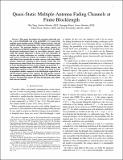Quasi-Static Multiple-Antenna Fading Channels at Finite Blocklength
Author(s)
Yang, Wei; Durisi, Giuseppe; Koch, Tobias; Polyanskiy, Yury
DownloadPolyanskiy_Quasi-static multiple.pdf (799.6Kb)
OPEN_ACCESS_POLICY
Open Access Policy
Creative Commons Attribution-Noncommercial-Share Alike
Terms of use
Metadata
Show full item recordAbstract
This paper investigates the maximal achievable rate for a given blocklength and error probability over quasi-static multiple-input multiple-output fading channels, with and without channel state information at the transmitter and/or the receiver. The principal finding is that outage capacity, despite being an asymptotic quantity, is a sharp proxy for the finite-blocklength fundamental limits of slow-fading channels. Specifically, the channel dispersion is shown to be zero regardless of whether the fading realizations are available at both transmitter and receiver, at only one of them, or at neither of them. These results follow from analytically tractable converse and achievability bounds. Numerical evaluation of these bounds verifies that zero dispersion may indeed imply fast convergence to the outage capacity as the blocklength increases. In the example of a particular 1 × 2 single-input multiple-output Rician fading channel, the blocklength required to achieve 90% of capacity is about an order of magnitude smaller compared with the blocklength required for an AWGN channel with the same capacity. For this specific scenario, the coding/decoding schemes adopted in the LTE-Advanced standard are benchmarked against the finite-blocklength achievability and converse bounds.
Date issued
2014-07Department
Massachusetts Institute of Technology. Department of Electrical Engineering and Computer ScienceJournal
IEEE Transactions on Information Theory
Publisher
Institute of Electrical and Electronics Engineers (IEEE)
Citation
Yang, Wei, Giuseppe Durisi, Tobias Koch, and Yury Polyanskiy. “Quasi-Static Multiple-Antenna Fading Channels at Finite Blocklength.” IEEE Trans. Inform. Theory 60, no. 7 (July 2014): 4232–4265.
Version: Author's final manuscript
ISSN
0018-9448
1557-9654